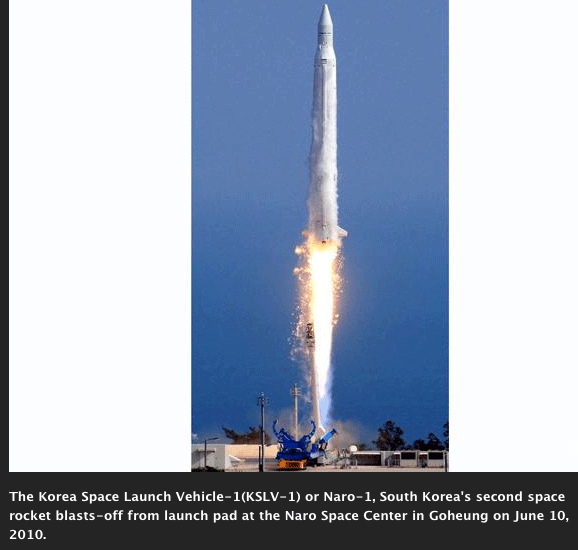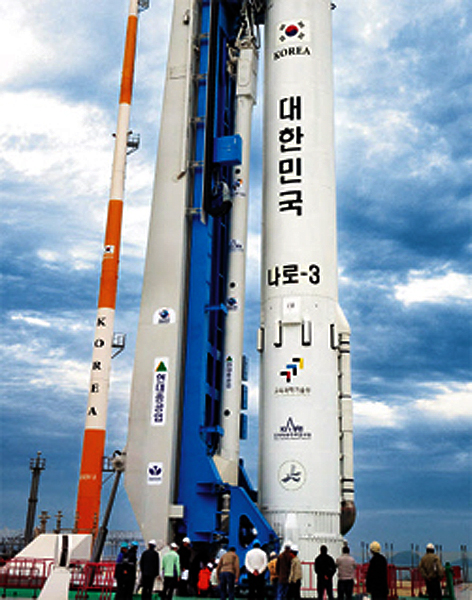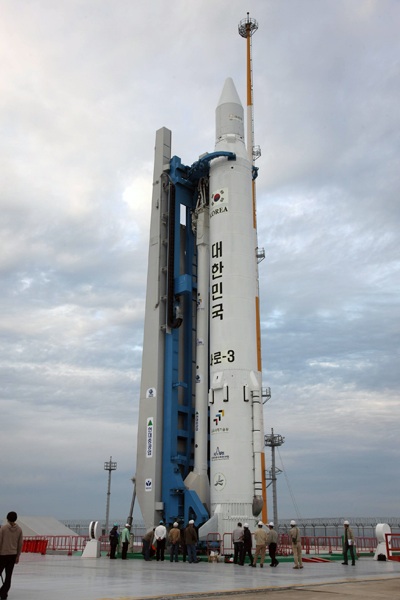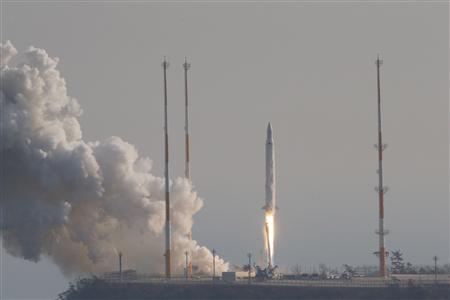-
Korea's highly anticipated Naro space rocket launch, originally scheduled for this afternoon, has been delayed indefinitely, after officials discovered a gas leak in the first stage rocket.
The initial plan was to launch the rocket at around 3:30 PM, Korea time.
We will now connect live with Arirang News' Naro correspondent Song Ji-sun who is standing by at Naro Space Center to find out what exactly caused officials to delay the launch.
So, Ji-sun, how and when did they find out about this defect this news broke within the hour and has come as a big shock to the whole country How are officials reacting down there The launch will be delayed at least for three days from now and possibly indefinitely What's the new timeline like Alright. Thanks, Ji-sun, for the updates.
Arirang's Naro correspondent Song Ji-sun there on the abrupt delay in the launch of Korea's Naro space rocket from launch site in Goheung.
We will have more updates for you throughout the day today.
Update: 27.10.2012
Probe Begins on Naro Defect Korean and Russian engineers are now investigating a glitch with the Naro rocket that prevented its scheduled launch on Friday.
A helium leak was discovered five hours before the due launch in Goheung, South Jeolla Province.
Authorities cited a torn rubber seal and a resulting leak in the connection between the first stage rocket and the launch pad that released the helium gas.
The Korea Aerospace Research Institute and Russia's Khrunichev Space Center are probing the exact cause.
For now, the Korea institute says they will pinpoint and fix the problem.
The launch is likely to be rescheduled for next month after notifying the international aerospace authorities.
-
Update: 28.10.2012 Neues Start-Fenster 20.11.2012
South Korea will most likely put off its third attempt to launch a satellite with its first-ever space carrier rocket, KSLV-1, for three or four weeks after an unsuccessful try on Friday, a source in the Russian space rocket industry said on Saturday.
"The South Koreans simply won't be able to fit into the current launch window for the satellite, which opened on October 26 and closes on October 31," the source told Interfax-AVN. The next window would open after November 20, he said.
"They take three days to take a rocket to the launch pad and test it," he explained. "And, moreover, they still have to replace the sealer in the device that connects the fuel supply unit to the first stage of the carrier rocket."
The first two launch attempts were made in 2009 and 2010. Both of them failed. Development of the first South Korean rocket began 10 years ago.
Early next week, Russian and South Korean specialists will try to find out the cause of the damage to the sealer, the source said.
"The joint Russian-South Korean commission will definitively set the date for the launch early next week," he said.
"Obtaining the approval of the launch window from the International Civil Aviation Organization is a procedure that takes eight to 10 days," the source said.
Quelle: Roscosmos
-
Update: 29.10.2012
South Korea on Monday set new candidate dates for the launch of its first space rocket after a previously scheduled launch was called off due to a defective part.
The Launch Preparation Committee set Nov. 9-24 as new candidate dates for the launch of the Korea Space Launch Vehicle-1 (KSLV-1), with Nov. 9 singled out as the most likely date.
Singling out a specific date is for convenience reasons only, and the actual launch could take place on any of the candidate dates, the committee said.
"Based on the interim outcome of an investigation on the defective part and considering the amount of time needed for a more thorough investigation and to take necessary steps, the committee decided the launch of the KSLV-1 will be possible starting from Nov. 9," it said in a press release.
The rocket, also known as Naro-1, was earlier set to be launched Friday, but the launch was called off due to a broken rubber seal in the connector between the launch pad and the rocket's first-stage thrust engine.
The launch committee had originally set Oct. 26-31 as candidate launch dates, but committee officials said the ongoing investigation on the defective part of the rocket will not be completed for another several days.
South Korea has agreed to send the broken seal back to its Russian manufacturer, the Khrunichev State Research and Production Space Center, to see if the seal is the only problem or if it broke because of other undetected problems, such as a gap between the seal and the part it surrounds, according to the Korea Aerospace Research Institute (KARI), South Korea's main space program developer.
"No gas leak or damage to a replaced seal was detected in a test for airtightness conducted on Oct. 27 and the Korea-Russia Flight Test Committee, which was convened in the afternoon of Oct. 27, has decided the problem was insignificant," the Launch Preparation Committee said.
"However, the research teams of South Korea and Russia agreed to conduct an additional analysis as part of efforts to more thoroughly prepare for an eventual launch and send the damaged seal to Moscow today for an additional analysis," it added.
The process will take at least 4-5 days, it said, which means a launch within the earlier set dates, which ends on Wednesday, will not be possible.
There are only certain periods throughout the year when a space rocket can be sent into space due to various issues, such as solar activity.
A KARI official earlier said such a time window is only open till mid-November this year.
South Korea's two earlier attempts to send the KSLV-1 into space in August 2009 and June 2010 ended in failure.
-
Update: 3.11.2012
Naro Investigation Results to Be Announced Monday Officials say soon we will know exactly what caused the postponement of last Friday's Naro rocket launch.
Russian and Korean scientists will meet this weekend to discuss the results of an investigation into the broken rubber ring that prompted authorities to halt the launch.
Korea's science ministry will make an official announcement about the investigation before noon on Monday.
-
Update: 5.11.2012
South Korea and Russian engineers have confirmed the problem in South Korea's space rocket is more serious than earlier thought, the Seoul government said Monday, further delaying the scheduled launch of the rocket.
The Korea Space Launch Vehicle-1 (KSLV-1) was scheduled to be launched on Oct. 26, but the launch has been delayed at least until Friday due to a damaged rubber seal in a connector that links the rocket to its launch pad.
The Russian manufacturer of the first-stage rocket of the KSLV-1 has been working to identify the cause of the damage to the seal and has confirmed there is a gap between the rubber seal and steel component of the rocket.
The problem recurred when helium, which is used to pressurize the rocket's fuel tanks and also control various rocket devices, was injected for over three hours, according to South Korea's rocket Launch Preparation Committee.
The problem disappeared after the defective steel component in the connector was replaced with a spare part, it said.
"A new launch date will be set after all necessary tests and measures are first taken," the committee said in a press release.
The committee earlier set Nov. 9-24 as candidate launch dates.
The upcoming launch will be South Korea's third attempt to send the KSLV-1, also known as Naro-1, into space after its earlier attempts in August 2009 and June 2010 ended in failure.
-
Update 6.11.2012
The delay in the Oct. 26 attempt to launch the Naro-1 space rocket, or Korea Space Launch Vehicle-1 (KSLV-1), was caused by a link port (adapter bloc), not an O-shaped ring in the first-stage rocket, said the Education, Science and Technology Ministry on Monday.
Noh Gyeong-won, head of the ministry`s strategic technology development bureau, told a briefing at the Central Government Complex in Seoul, “Scientists concluded that there was a tiny defect on a bar-shaped pipe used as a latch in the middle section of the link port. Thus, the link was loosened and a gap was created in-between the rocket and link port.” As a result, he said, the O-shaped ring within the link port failed to resist high pressure and ruptured.
The cylindrical link port measuring 40 centimeters high and across is the section that connects the inlet at the rocket’s bottom with devices for the supply of fuel and helium gas on the ground. The port is designed to remain attached to the rocket and supplies fuel and helium gas in the course of preparation for lift-off. The latch is released right before blast-off to be separated from the rocket.
Noh said, “We will bring in a new adapter bloc assembly as a whole from Russia, replace it, and test the new one before preparing for launch.”
The new launch date has yet to be fixed. The ministry and the Korea Aerospace Research Institute will pick a date after examining the preparation process for the rocket. Noh said, “We expect to be able to launch it by Nov. 24, which was designated as a preliminary launch date.”
On criticism that authorities might have set a preliminary launch date even before the exact cause of the delay was founded, the ministry said, “The adapter bloc is not a core part that determines the thrust of the rocket like the Stage 1 rocket engine. We set the preliminary date for the launch with ample time to spare by predicting a situation where a part is brought in from Russia and replaced.”
-
Update: 14.11.2012
South Korea's planned launch of a space rocket will likely be further delayed, government officials said Wednesday, as the Russian replacement for a defective part in the Korea Space Launch Vehicle-1 (KSLV-1) is not expected to arrive here until the end of the week.
The Ministry of Education, Science and Technology and its Launch Preparation Committee earlier said the launch of the KSLV-1 would take place before Nov. 24.
The replacement of the defective part, however, will likely arrive here on Saturday, ministry officials said. It will take two to three days to replace and test the new part with preparations for the actual launch expected to take up to another seven days.
Officials said there would not be any major problem launching the space rocket, also known as Naro-1, after the designated date, as long as the country informs related international organizations, such as the International Civil Aviation Organization, in advance.
"There is a growing voice that we must not hurry to meet the designated date as a successful launch is more important than anything else," an official said, adding the launch will likely take place before the end of the month.
The country earlier planned to fire the Naro-1 on Oct. 26 but the plan was pushed back after a broken rubber seal in the connector between the rocket and its launch pad was found only hours before the scheduled launch.
The problem was originally thought to be a minor issue but Russian engineers, who built the connector along with the rest of the first-stage rocket of the KSLV-1, later found the seal was damaged due to a gap between the seal and the connector's steel component.
-
Update: 24.11.2012
New Rocket Launch Set for Next Thursday
The third and final launch attempt for the homegrown Korean rocket Naro has now been set for 4 p.m. next Thursday, the Ministry of Education, Science and Technology said.
The exact time will be finalized at 1:30 p.m. on the day. Just in case of a further delay, the ministry told relevant international organizations that the new launch window ends on Dec. 5.
The launch had to be abandoned at the last minute in late October because of a faulty part.
If the launch again fails to materialize within the new window, the ministry will delay it until next year.
Korean and Russian experts will finish checking all aspects of the rocket by the end of this week. If no errors are found, the rocket will be taken to the launch pad on Monday and a rehearsal held on Tuesday.
Update: 26.11.2012
Preparations for Naro's Thursday Lift-off in Full Swing
Preparations are in full swing as Korea makes another attempt to launch its Naro space rocket on Thursday.
The preparation committee said the Naro rocket is undergoing the final inspections before it is transferred onto the launch pad Tuesday morning.
There will be a final pre-launch rehearsal on Wednesday.
If the inspections go smoothly and there are no additional technical problems, the launch will take place sometime between 4 and 6-fifty-five PM local time, depending on the weather conditions that day.
-
Update: 29.11.2012
(Naro) Fate of Naro-1 to be determined in just 9 minutes
SEOUL, Nov. 28 (Yonhap) -- Despite years and thousands of experiments and simulations preparing for this week's launch of the Korea Space Launch Vehicle-1 (KSLV-1), its success or failure will be determined in just nine minutes after liftoff, experts said Wednesday.
The KSLV-1, also known as Naro-1, is set to be fired off Thursday from the country's Naro Space Center, 480 kilometers south of Seoul.
Whether or not the rocket will actually be launched depends on many issues, including weather conditions, but once it is launched, it will take 540 seconds to decide whether the launch, and thus the country's ongoing space program, is successful, according to officials from the Korea Aerospace Research Institute, the main developer of the KSLV-1.
During the 10 seconds immediately following the liftoff from its launch pad, the rocket will make a "kick-turn" maneuver, which is designed to align the rocket's thrust to the open space next to the launch pad so the exhaust from the expensive rocket will not damage the equally expensive launch pad.
Just 54 seconds after the launch, the rocket will break the sound barrier when it reaches an altitude of 7.4 kilometers.
When it reaches an altitude of 177 kilometers at 215 seconds after liftoff, the far fairings that cover the rocket's payload satellite, the Science and Technology Satellite-2C (STSAT-2C), will be ejected.
Exactly 17 seconds after the ejection of the fairings, or 232 seconds after takeoff, the first-stage rocket should separate from the upper second-stage rocket that carries the satellite. The rocket will have reached an altitude of 193 kilometers by then.
At 303 kilometers above ground, or 395 seconds after liftoff, the second-stage rocket will ignite and push the satellite further into space for 58 seconds until it reaches an altitude of 305 kilometers.
At 9 minutes or 540 seconds after takeoff, the near fairings at the tip of the rocket will be ejected to allow separation of the satellite from the second-stage rocket. The satellite will then move into its orbit at a speed of 8 kilometers per second.
If all goes well, the satellite will transmit its first beacon signal approximately 2 hours and 20 minutes after the launch and make its first contact with the country's ground station located at the Korea Advanced Institute of Science and Technology about 13 hours after the launch.
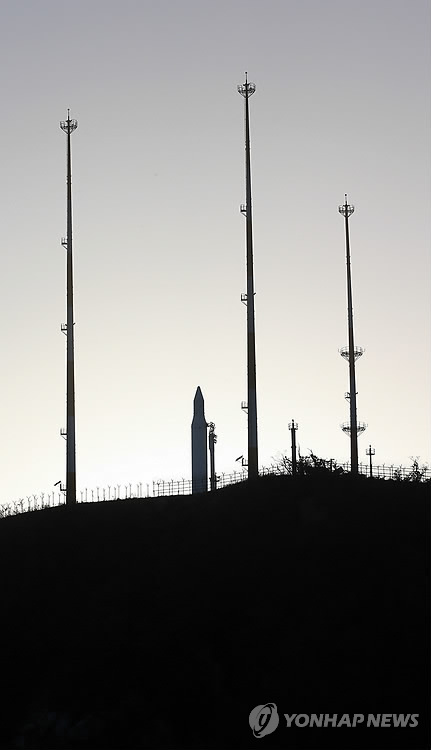
-
Update: 29.11.2012 / 16.00 MEZ
Naro Rocket Launch Halted Again
Just minutes before what could have been a historic moment for Korea, the third and final launch of the Naro was put on hold indefinitely.
Engineers are currently inspecting what went wrong, but for now, we connect to our Hwang Sung-hee at the Naro Space Center for the latest.
Sung-hee, what caused the delay this time[Reporter : ] Hi guys.
The third and final launch of the Naro that was scheduled for 4 p.m. this afternoon will not be taking place today, or may be even this year.
The problem was detected as engineers were counting down, about 16 minutes before lift-off and the cancellation was made at 4:08 p.m.
Engineers discovered an irregularity at the tip of the Naro that allows for the rocket to manipulate the direction of the thrust from its engine or motor.
The problem was detected in the second stage of the two-stage rocket - the Naro is jointly built by Russia and Korea.
Russia built the first-stage and Korea the second-stage.
This is the second postponement in two months, and the reason Korea is being so careful with the third launch is because it would be the Naro-1's last chance for a successful launch.
Russia has agreed to provide the thruster engine for a maximum of three launches.
Sung-hee, will we be able to see the Naro lift-off anytime soon[Reporter : ] Unfortunately, no.
Nothing is for sure, but according to Korea's science minister just now, there is high chance the Naro's third launch may not happen this year.
The Naro will be brought back to the assembly complex for closer inspection, and engineers say this process itself will take at least one day.
A closer inspection of what went wrong will probably be conducted for about three to four days, starting on Saturday.
Officials here are skeptical about meeting the current launch deadline of December 5th.
Nothing's for sure yet.
The defect was just discovered, so the engineers are still trying to determine the cause of the problem.
Back to you, guys.
Thank you, Sung-hee.
That was our Hwang Sung-hee reporting live from the Naro Space Center in South Jeolla Province.
-
Update: 29.11.2012 / 22.00 MEZ
GOHEUNG, South Jeolla Province - The nation’s third attempt to launch the Korea Space Launch Vehicle-1 (KSLV-1) was again aborted Thursday, due to problems in the second-stage of the rocket, colloquially known as Naro.
The Korea Aerospace Research Institute (KARI) said that it will determine the next launch date after a thorough inspection of the KSLV-1, but it is unlikely that the liftoff will take place this year as the current launch deadline is scheduled to end on Dec. 5. Engineers say it will take at least four to five days to figure out what went wrong and fix it.
The countdown was abruptly stopped 16 minutes and 52 seconds before the launch time of 4 p.m. The Ministry of Education, Science and Technology immediately announced that there was a signal error from a thrust controller in the upper part of the rocket. The launch was officially aborted at 4:08 p.m.
“It is regrettable that we must set another launch date in front of people who have cheered us on so far,” said Minister Lee Ju-ho, in an emergency briefing after the launch was canceled. “During the countdown we found an electronic signal problem with the thrust vector controller in the second stage and decided a launch will be impossible today.”
“We are investigating the cause and we will announce a revised schedule later. We will prepare and inspect the rocket more thoroughly so that the third launch will be a success,” he said.
Lee said the launch will be focused on success, hinting at a possible delay until spring next year.
Also at the briefing, KARI President Kim Seung-jo said every attempt was made to fix the controller to continue the launch but to no avail. It continued to consume more electricity than needed, forcing the cancelation.
Kim said the rocket will be moved to its assembly complex for a “thorough inspection.” The thrust controller located in the second stage controls the vector of the nose. It is used for quick turns to control direction.
This is the second postponement in two months. The government is being so careful with the third launch because it would be the last chance for a successful liftoff of the KSLV-1. Russia agreed to provide the first stage of the rocket for a maximum of three launches.
Under the current window date, KARI is allowed to make another launch attempt until Dec. 5. Kim, though unable to provide a specific date, said that is was highly unlikely that they could make another attempt within the current window.
Cho Gwang-rae, who heads the Naro project at KARI, said the problematic part was locally made and there were many spare parts. He said the electronics device that requires inspection can only be fixed after disassembling the rocket, which will require at least two days from Thursday.
Cho added that no problems were detected during two checkups conducted on the launch date and the previous day’s rehearsals.
He denied some allegations that perhaps the part, which was built five years ago, was reaching its expiration date. The institute said it had two spares for the problematic electronics part of the controller, which was made in France.
Russian officials told local media that from the current data, it seemed parts must be replaced with the rocket moving to the assembly complex. All fuel has been removed from the rocket as of 6:15 p.m. and it will be moved into the complex by today.
The disappointing outcome follows two previous failures. In the first attempt in 2009, the rocket reached the desired orbit but failed to release its satellite due to a fairing malfunction. The second attempt saw the rocket explode minutes after its launch in 2010.
KARI estimates that its current space technology has advanced to 83.4 percent to that of developed countries from 46.3 percent before the KSLV-1 project began.
Korea plans to continue expanding its decade-long space program to legitimately join the so-called “space club” of the United States, France, Russia, Japan, China, the U.K., India, Israel and Iran.
The project to launch the first locally assembled rocket was initiated in 2002 in collaboration with Russia. The two have signed cooperative and technology safeguard agreements over the years.
For the two-staged rocket, Korea built the second stage that contains a locally assembled satellite as its payload and uses a solid-fuel kick motor as its engine. The larger first stage was built by Russia and is powered by liquid oxygen and highly-refine kerosene.
Naro weighs 140 tons and is 33 meters long when fully assembled. It is carrying a 100-kilogram satellite - the Science and Technology Satellite-2C.
The total spending on the KSLV-1 including assembly and launches will be over 520 billion won. The Naro Space Center, initially planned to be built on Jeju Island, is located in Goheung, South Jeolla Province and cost 300 billion won.
Seoul launched three test rockets, called Korea Sounding Rockets, prior to Naro in 1993, 1998 and 2002 before starting serious discussion to build ones powerful enough to reach orbit.
It will now initiate plans to build and launch the KSLV-2 with a budget of 1.54 trillion won.
This rocket will be much larger and powerful, weighing 200 tons and being 47.5 meters long when assembled. It will be a three-stage launch vehicle and have a larger payload - a 1.5 ton satellite. The first and second stages will use liquid fuel-powered 75-ton thrust engines that will be completed by 2018.
A vehicle using the locally made engines will be tested by 2018 before the KSLV-2. KARI said that they have acquired key technology to make a 30-ton thrust engine through cooperation with Russia, which will be the foundation to build the larger rocket.
KARI said over 80 percent of the three-stage KSLV-2 will be made here.
Korea plans to build its own 300-ton thrust engine by 2022 to be used in yet to be specified future projects. Tentatively, the country plans to send an orbital probe to the moon by 2023, and one that will land on the lunar surface by 2025.
Goheung County has been bench marking France and Japan to build a space cluster in the vicinity of the space center. Around 1 trillion won will be spent by 2016 to build additional test facilities and housing.
Update: 11.01.2013
Korea's Naro Rocket Likely to be Launched This Month Korea's first space launch vehicle,.. the Naro will likely return to its launch pad as early as this month, after the country's third attempt to send the rocket into orbit last November was called off due to a technical failure.
The Ministry of Education, Science and Technology says the Launch Preparation Committee will hold a meeting next week to set the blast-off date and back-up dates.
Officials say technical faults in the Naro rocket have been completely repaired and checked, and the first and second stage of the rocket will be re-assembled next week.
-
Update: 16.01.2013
Seoul to launch Naro space rocket between Jan. 30-Feb. 8
SEOUL, Jan. 16 (Yonhap) -- South Korea will launch its Korea Space Launch Vehicle-1 (KSLV-1) between Jan. 30 and Feb. 8, a government committee said Wednesday.
It will be the country's third attempt to send off the space rocket, also known as Naro, after its two earlier attempts in 2009 and 2010 ended in failures.
"After reviewing technical issues, the Launch Preparation Committee has decided to push for the third launch of Naro between Jan. 30 and Feb. 8 with the final launch date to be decided later, depending on weather conditions and other issues," it said in a released statement.
The third launch of the KSLV-1 was originally set to take place on Oct. 26 but was delayed due to a damaged rubber seal in the connector between the rocket and the launch pad.
The rocket was then set to lift off on Nov. 11, but the launch was again postponed, this time with only minutes left on the launch countdown clock, due to what South Korean engineers earlier called "unusual signals" from the rocket's thrust system.
The launch committee on Wednesday said the latest problem with the rocket's thrust vector system was caused by a defective hydraulic motor, which has since been replaced.
Currently lacking related technology, South Korea relied on Russia's Khrunichev State Research and Production Space Center to build the lower section or first-stage of the two KSLV-1 launched in 2009 and 2010, as well as the latest version set to be launched late this month or early next month.
Still, a successful launch of the Naro space rocket will make South Korea the world's only 13th nation to have sent off a space rocket from its own soil.
The ongoing Naro space program ends later this year, but a new program to develop the country's space launch vehicle is already under way.
Under the new program, South Korea seeks to develop an indigenous 75-ton thrust engine by 2018 and a 300-ton space rocket for launch in 2021.
yonhab-news
Update: 23.01.2013
-
Seoul to set definite date for launch of Naro space rocket
SEOUL, Jan. 23 (Yonhap) -- South Korea will this week set a more definite date for the liftoff of its Korea Space Launch Vehicle-1 (KSLV-1), the government said Wednesday.
The country's Launch Preparation Committee earlier set Jan. 30-Feb. 8 as possible dates for what will be its third launch of KSLV-1, also known as Naro.
"The committee will be convened at 11 a.m. Thursday and select a launch date within the candidate dates after reviewing technical preparations and weather conditions," the Ministry of Education, Science and Technology said in a statement.
The country's first two attempts to send the KSLV-1 into space in 2009 and 2010 ended in failures. A successful launch of the space rocket will make the country the world's 13th nation to send a satellite into space from its own soil.
The third launch of the KSLV-1 was originally set to take place on Oct. 26 but was delayed due to a damaged rubber seal in the connector between the rocket and the launch pad.
The rocket was then set to lift off on Nov. 11, but the launch was again postponed with only minutes left on the launch countdown clock, due to what South Korean engineers earlier called "unusual signals" from the rocket's thrust system.
The launch committee earlier said the latest problem with the rocket's thrust vector system was caused by a defective hydraulic motor in the upper or second-stage rocket of Naro. The defective part has been replaced.
The lower and larger thrust engine of the two-stage Naro was built by Russia as South Korea currently lacks related technology. The upper and lighter stage of the rocket was indigenously developed by the Korea Aerospace Research Institute and some 200 other companies and research centers here.
The ongoing Naro space program ends later in the year, but a separate program to develop the country's own space launch vehicle is already under way.
Under the program, the country seeks to develop an indigenous 75-ton thrust engine by 2018, which will be used in a group of four to create a 300-ton thrust engine that is set to be launched in 2021.
Quelle: Yonhab
-
Update: 24.01.2013
.
S. Korea's Naro space rocket set to blast off on Jan. 30
SEOUL, Jan. 24 (Yonhap) -- South Korea will again seek to join the elite global space club next week with a third launch of its Korea Space Launch Vehicle-1 (KSLV-1), the science ministry said Thursday.
The space rocket, also known as Naro, will be launched Wednesday from the country's Naro Space Center, 480 kilometers south of Seoul, the Ministry of Education, Science and Technology said in a released statement. The decision came at a meeting of the Launch Preparation Committee.
"After reviewing launch preparations and weather forecasts, the committee has confirmed the third launch of the Naro will be possible on Jan. 30 as of now," the ministry said.
The launch committee earlier set Jan. 30-Feb. 8 as candidate dates for the scheduled launch.
It will be South Korea's third attempt to send the KSLV-1 into space after its two attempts in 2009 and 2010 ended in failures.
A successful launch will make South Korea the world's 13th nation to have ever sent a rocket into space from its own soil.
The country has sent up about 10 satellites, but all using foreign space rockets and from foreign soil.
Separate from the ongoing Naro space program, which is set to end later in the year, the country is working to develop its own space launch vehicles with plans to launch an indigenous space rocket with a 300-ton thrust in 2021.
Quelle: Yonhab
(Naro) Site of space rocket launch to become home of S. Korea's space program
NARO SPACE CENTER, South Korea, Jan. 29 (Yonhap) -- The Naro Space Center, the site of South Korea's planned space rocket launch, will be further developed into the home of South Korea's space development program that seeks to produce an indigenous space rocket by 2021, center operators said Tuesday.
The center, located 485 kilometers south of Seoul, is again in the media spotlight as the country prepares to launch its Korea Space Launch Vehicle-1 (KSLV-1), also known as Naro, on Wednesday.
The launch will be South Korea's third attempt to send Naro into space after two botched attempts in August 2009 and June 2010.
The Naro Space Center currently sits on 5.11 million square meters of land after its first development plan was completed in June 2010, costing 331.4 billion won (US$301 million), according to the Korea Aerospace Research Institute (KARI), the state-run operator of the center.
It is equipped with a state-of-the-art mission director center, flight safety control facilities and a launch pad. It also has a meteorological observatory and a rocket assembly facility, along with radar and optical tracking systems that can follow the trajectory of rockets fired.
A second 582.7-billion-won development plan began in 2009 to further expand the center and build an engine combustion test facility, which is an essential component for the development of the country's indigenous rockets, according to KARI.
The KSLV-1 is a two-stage rocket with a Russian-built first stage engine and a South Korean-made second-stage rocket.
The ongoing Naro space program ends later this year, but the National Science and Technology Commission has already approved a new five-year space program that aims to develop an indigenous 10-ton thrust engine by 2016.
The second five-year program, along with the ongoing Naro development plans, are part of a long-term goal that seeks to develop a 300-ton thrust engine that can carry a 1.5-ton satellite into space by 2021.
To this end, KARI seeks to launch 14 new projects, costing a total of 1.61 trillion won, which will include the construction of a space vehicle test center, as well as a training facility for astronauts.
"By securing a means to train the country's own astronauts, we can prepare for the country's advance into an exclusive club of countries with advanced space technologies," KARI said.
Quelle: Yonhab
-
Update: 30.01.2013
South Korea launches rocket carrying satellite in battle for space supremacy
Launch of 140-tonne rocket likely to anger North Korea, which incurred tougher UN sanctions after December launch
-
-
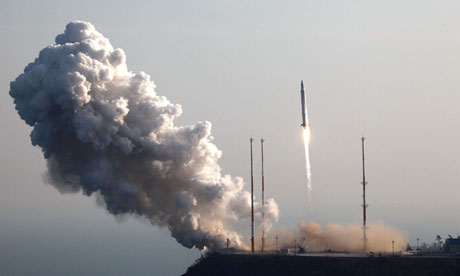
The battle for space supremacy on the Korean peninsula intensified on Wednesday when South Korea launched its first satellite, weeks after a similar launch by North Korea.
Relief greeted the Naro rocket's flawless liftoff from a space centre on the south coast at 4pm local time. South Korea had twice failed to put a satellite into space, while two further attempts last year were aborted due to last-minute technical problems.
Reports from Seoul said the 140-tonne rocket, which was built in Russia and South Korea, successfully completed its stage separation before the satellite entered orbit. There was no immediate confirmation that the satellite was following its intended trajectory.
Before Wednesday, all of South Korea's satellite launches had been from overseas sites using foreign-made rockets. The country is thought to have about 10 satellites in orbit.
US experts believe the satellite launched by North Korea on 12 December is tumbling through space, despite claims by Pyongyang that it is functioning normally.
Seoul's launch is likely to anger the North, which incurred tougher UN sanctions after its recent launch.
The regime insists rocket technology is central to its peaceful space programme, but the US, South Korea and Japan say the launches are being used to test ballistic missile technology.
The North appeared to confirm those suspicions last week when its top military body, the national defence commission, said the rocket programme's secondary purpose was to target the US.
North Korea responded to widespread condemnation of its latest rocket launch and tighter sanctions with a threat to conduct a third nuclear test, as early as next month. Possible dates are the birthday of its former leader, Kim Jong-il, on 16 February, or the inauguration of South Korea's newly elected president, Park Geun-hye, on 25 February.
Intelligence officials in Seoul believe the North has a rocket capable of travelling 6,200 miles, potentially putting San Francisco in range, but it is not yet capable of mounting a long-range missile with a nuclear warhead.
Quelle:TheGuardian
-
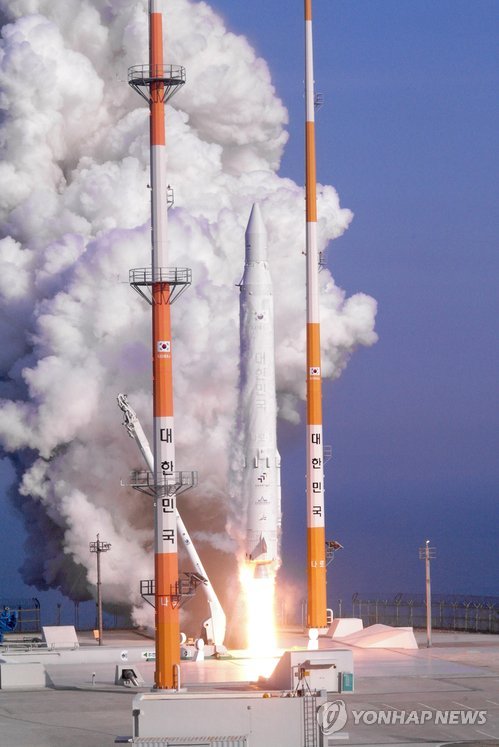
S. Korea successfully launches space rocket
The Korea Space Launch Vehicle-1, carrying a science satellite, blasts off at the Naro Space Center in Goheung on South Korea's south coast on Jan. 30, 2013, in this photo released by the Korea Aerospace Research Institute. The institute launched the Science and Technology Satellite-2C using the rocket also known as Naro. (Yonhap)
-
South Korea's apparently successful launch of its first-ever space rocket has opened a new chapter in the country's history as well as unlimited room and opportunities for its space development program, experts said Wednesday.
The Korea Space Launch Vehicle-1 (KSLV-1) lifted off from the country's Naro Space Center at 4 p.m. An initial confirmation of whether the launch was successful will be made when and if the beacon signal from the rocket's payload satellite is detected by a ground station in Norway about 140 minutes after its takeoff from the launch site, located 480 kilometers south of Seoul.
The satellite will make its first contact with South Korea's own ground station in approximately 12 hours after the liftoff of the space rocket, also known as Naro.
However, officials from the Korea Aerospace Research Institute (KARI) noted the launch itself appears to have been successful with the satellite also safely deployed into its intended orbit.
The experts said the confirmation of successful deployment of the satellite will mark success not only in Wednesday's rocket launch but also in the country's current space program.
"I do not believe the satellite will cause any problem as our country possesses one of the most advanced satellite technologies," said Lee Chang-jin, a professor of aerospace engineering from Seoul's Konkuk University.
"But if the launch is, in fact, determined to have been successful, its significance will just be enormous. It will mean the scope of areas our country has access to has been expanded into space," he said in a telephone interview with Yonhap.
The current Naro space program began in 2002 with the help of Russia, as Seoul had then lacked related technologies. The lower or first-stage rocket of Naro was built by Russia's Khrunichev State Research and Production Space Center with the upper or second-stage rocket of Naro built jointly by KARI and some 200 other South Korean companies and institutes.
Many doubt even a successful launch of the KSLV-1 will offer any help to Seoul's future development of its own space launch vehicles, especially as Russia strictly denied South Korean engineers any access to its rocket technology.
An official from KARI noted the lower stage of a space rocket is of course more important than the upper part of a rocket, but said that did not mean the country's indigenous upper-stage engine used in Naro was insignificant.
"The first-stage rocket is important but the first-stage rocket is not all we need. We also need to have a second-stage thrust engine and the technology to separate different stages of a space rocket, as well as the means to monitor and follow a space rocket," the official said.
"In that sense, we now only have to develop a first-stage rocket," he added.
The Konkuk University professor agreed.
"The successful launch of the Naro means we have comprehensively tested all the required capabilities and that we were successful in everything only except for the first-stage rocket," Lee said.
The Naro space program is set to end in April, but the country is already moving to develop its own 10-ton thrust engine by 2016 and a 75-ton thrust engine by 2018.
It plans to develop and launch an indigenous 300-ton thrust space rocket in 2021.
Wednesday's launch, if confirmed successful, will make South Korea the world's 13th nation to have ever sent a satellite into space from its own soil.
South Korea had so far sent about 10 satellites into space, but all of them were launched from foreign soil, using foreign space rockets.
Update: 31.01.2013
S. Korea's new satellite makes contact with ground station
DAEJEON, South Korea, Jan. 31 (Yonhap) -- South Korea's new science satellite successfully made contact with a ground station here Thursday, marking a complete success in the country's launch of its first-ever space rocket on the previous day, officials said.
The first communication contact was made at 3:27:12 a.m., according to officials from the country's Satellite Technology Research Center at the Korea Advanced Institute of Science and Technology in Daejeon, 160 kilometers south of Seoul.
The contact came after the Korea Space Launch Vehicle-1 (KSLV-1), carrying the 100-kilogram Science and Technology Satellite-2C, blasted off from the country's Naro Space Center at 4 p.m. Wednesday. The space center is 480 kilometers south of Seoul in Goheung, South Jeolla Province.
Wednesday's launch of the KSLV-1, also known as Naro, was initially determined successful after the satellite transmitted its beacon signal to a ground station in Norway, some 90 minutes after liftoff.
"At 4 p.m. today, the Naro was successfully launched. The satellite was deployed 540 seconds after the launch and an analysis of related data shows the satellite has successfully entered its target orbit," Science Minister Lee Ju-ho told a press conference earlier.
The successful launch of the space rocket and deployment of the satellite into its proper orbit makes South Korea the 13th nation to have successfully sent a satellite into space from its own soil. It was the country's third attempt to send the KSLV-1 into space; attempts in 2009 and 2010 ended in failure.
The country has so far sent 10 satellites into space, but all were launched from foreign soil, using foreign rockets.
The new satellite, developed indigenously by the Korea Advanced Institute of Science and Technology, orbits the Earth every 103 minutes or about 14 times a day.
However, it has a short operational lifespan of about one year as it was partly designed to test the country's ability to send a satellite into space.
The KSLV-1 was partly built by Russia's Khrunichev State Research and Production Space Center, but with its successful launch, Seoul plans to develop an indigenous space launch vehicle.
The country earlier had plans to develop its own space rocket with a 300-ton thrust by 2021. The science minister, however, said on Wednesday that the development program could be completed much earlier, in 2018 or 2019 with government support.
Quelle: Yonhab
